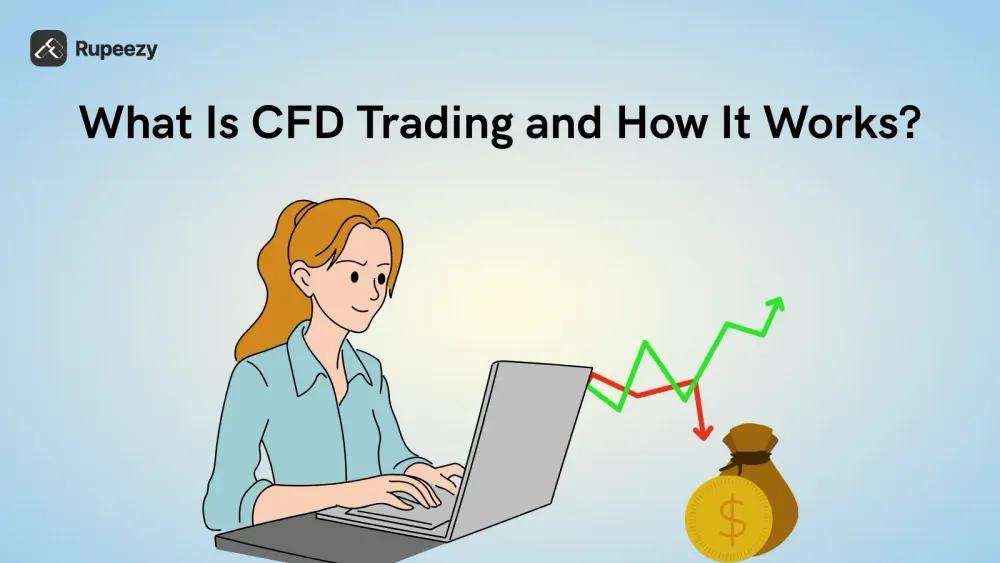What Is CFD Trading and How It Works?


00:00 / 00:00
People trade with the single aim of making profits. They try to plan and execute strategies that allow them to not just earn better returns but also ensure that they can build wealth as well. But when it comes to trading and investing in stocks, there are various terminologies that you need to work on.
Without actually understanding these terms, you are at risk. This can even impact your profitability and can sometimes lead to losses as well. One such term that you must know is CFD trading. In simplest terms, it is a way to speculate on prices in the market.
But the bigger question over here is how? Well, if you are a trader who is looking for an answer to the same, then read this guide. Understand what is CFD trading and how it works. Know how you can use it for better trades in the market.
What Is CFD Trading?
CFD trading is known as Contract for Difference trading. It is a way to speculate on the price movements of financial assets without actually owning them. In simple words, it is a type of trading strategy where you can earn profits from both the rise and fall in the market.
When you trade CFDs, you enter into a contract with a broker. This is mainly to exchange the difference in the asset’s value from when the position is opened to when it is closed. In such a case, you will face two situations, which are:
If the price moves in your favor, you earn a profit.
If it moves against you, you face a loss.
CFDs are available on a wide range of markets. These are available in stocks and shares, indices, commodities, and currencies. Traders often choose CFD trading for its flexibility, use of leverage, and ability to trade in both directions. This helps you to go ahead with the long (buy) and short (sell).
However, it also carries a higher risk. This is why it is very important that you understand the market before entering is crucial.
How Does CFD Trading Work?
CFD trading operates on a simple concept. Under this, you earn from the price movement of an asset without owning it. This is not about finding the right time to buy or sell. But here, you only predict whether the price will go up or down and place your trade accordingly. The two main ways to trade CFDs are discussed below:
1. Going Long (Buy Position)
You open a buy position when you expect the asset’s price to rise. If the market moves up, you earn the difference. This will be calculated between the opening and closing prices, which is then multiplied by the number of units traded.
But if the price drops, then you will be facing losses.
Example: You buy 100 CFDs of a stock at Rs. 500. If the price rises to Rs. 520, your profit is Rs. 20 × 100 = Rs. 2,000.
Now, on the other hand, say it falls to Rs. 480, your loss is Rs. 2,000.
2. Going Short (Sell Position)
You open a sell position. This is mainly when you expect the asset’s price to fall. If the market declines, you make a profit from the drop. But if the price rises, you face a loss.
Example: You sell 100 CFDs of a stock at Rs. 500. If the price falls to Rs. 480, you make Rs. 20 × 100 = Rs. 2,000 profit.
Now, say the same stock rises to Rs. 520. If this happens, you will face the loss of around Rs. 2,000.
3. Profit or Loss Calculation
The profit or loss is calculated by the formula:
Profit/Loss = (Closing Price – Opening Price) × Number of Units
For a long position, a price rise gives profit, and for a short position, a price fall gives profit.
CFD trading, therefore, allows you to benefit in both rising and falling markets. But since it involves leverage. This means both profits and losses can multiply. Hence, understanding the meaning and using of risk management is crucial.
How CFD Trading Works Step by Step
Once you understand going long and short, the next step is knowing how a CFD trade actually takes place. It involves a series of simple but crucial steps. These steps help you to identify the open and close positions as well as manage your trades well.
The steps that you must know are as follows:
1. Choose a Market
You can trade CFDs on various instruments. These include choices such as stocks, indices, commodities, forex, and cryptocurrencies. Select the one that fits your trading strategy and market knowledge.
2. Open a Position
Decide whether you want to buy (go long) or sell (go short). This should be entirely based on your market outlook. You don’t own the asset. Hence, you are only speculating on its price movement.
3. Trade on Margin
CFD trading allows you to open positions by paying only a fraction of the total trade value. This is what is called the margin. For example, if the margin is 10%, you can trade Rs. 1,00,000 worth of CFDs with Rs. 10,000.
4. Leverage Application
Leverage amplifies your exposure to the market. So, it helps you to increase your profit well. But at the same time, the chances of the losses rise as well. So, staying cautious becomes even more important here.
5. Monitor and Manage the Trade
Once your position is active, track price movements regularly. Use tools like stop-loss and take-profit orders. This will help you to manage your risk. Also, this will be your chance to lock in better profits as well.
6. Close the Position
You close your position when you decide to exit the trade. The difference between the opening and closing prices determines your profit or loss.
In simple terms, CFD trading is a flexible way to participate in financial markets. This is where you can start with smaller capitals and, with the right plan, can earn a good level of returns. But there is leverage and volatility involved in the process. This means, if you fail to actually move around the market in the right way, you will end up making losses.
Is CFD Trading Regulated by SEBI in India?
No, CFD trading is not regulated by SEBI. It is not allowed on any Indian exchange. There are many reasons why the regulatory bodies in India do not allow investors to engage in this trading. These are:
Leverage can sometimes lead to huge and uncertain losses. These are out of the control of trader.
There is no actual holding of the asset and just speculation on prices, which is risky.
Most of the CFD platforms are located outside India, and this makes it hard to keep a check on working policies.
In case of the broker default, there is no way to claim or file a complain,t which makes it a bad deal.
The chances of improper license and risk of lack of transparency are quite high.
In other words, CFD trading is not as safe as you might think. So, it is better that you go for trade in Futures and Options (F&O) on NSE or BSE, which are fully regulated by SEBI.
Pros and Cons of CFD Trading
CFD trading is one that has its pros and cons. Just like any othe method of trading, it offers you better chances of profits, but again, there are certain risks as well. So, knowing them will help you to not just plan your trades better but also ensure higher profits too. So, here are the ones to know.
Pros of CFD Trading
Trade in any kind of market, either falling or rising..
Access to global financial products is there.
Leverage allows you to hold better positions even with small capital.
No actual asset holding is needed.
Entry can be done with lower capital itself.
Cons of CFD Trading
Risk is high because of the leverage involved.
Volatility can lead to losses, thereby lacking reliability and stability.
Not regulated by SEBI in India.
Overnight holding charges may apply.
Quick losses can happen, which are hard to manage.
Conclusion
CFD trading is unique in its nature. It gives traders the freedom to speculate on price movements across global markets without owning any assets. It offers flexibility, leverage, and opportunities to profit in both directions. But at the same time, the risk due to leverage and volatility is high.
Also, this is not regulated by SEBI in India, which makes it an even a more riskier option. So, for the traders who are looking for better opportunities, going for the F&O is always good. It is regulated, managed, and offers you a safer choice. Also, the chances of profitability are good too.
So, if you are ready to trade well, register on Rupeezy, your partner for smarter investing.
FAQs
Can I trade CFDs legally in India?
No, CFD trading is not legal in India as SEBI does not allow Indian brokers or exchanges to offer it.
What are the risks involved in CFD trading?
High leverage, market volatility, and unregulated brokers can lead to major financial losses.
Do I need a Demat account for CFD trading?
No, CFDs do not require a Demat account. This is because you do not own the actual asset.
Which is better for Indian traders, CFDs or F&O?
Futures and Options are better since they are regulated by SEBI and offer investor protection.
Can I learn CFD trading before investing real money?
Yes, most international brokers offer demo accounts where you can practice CFD trading with
The content on this blog is for educational purposes only and should not be considered investment advice. While we strive for accuracy, some information may contain errors or delays in updates.
Mentions of stocks or investment products are solely for informational purposes and do not constitute recommendations. Investors should conduct their own research before making any decisions.
Investing in financial markets are subject to market risks, and past performance does not guarantee future results. It is advisable to consult a qualified financial professional, review official documents, and verify information independently before making investment decisions.

All Category









